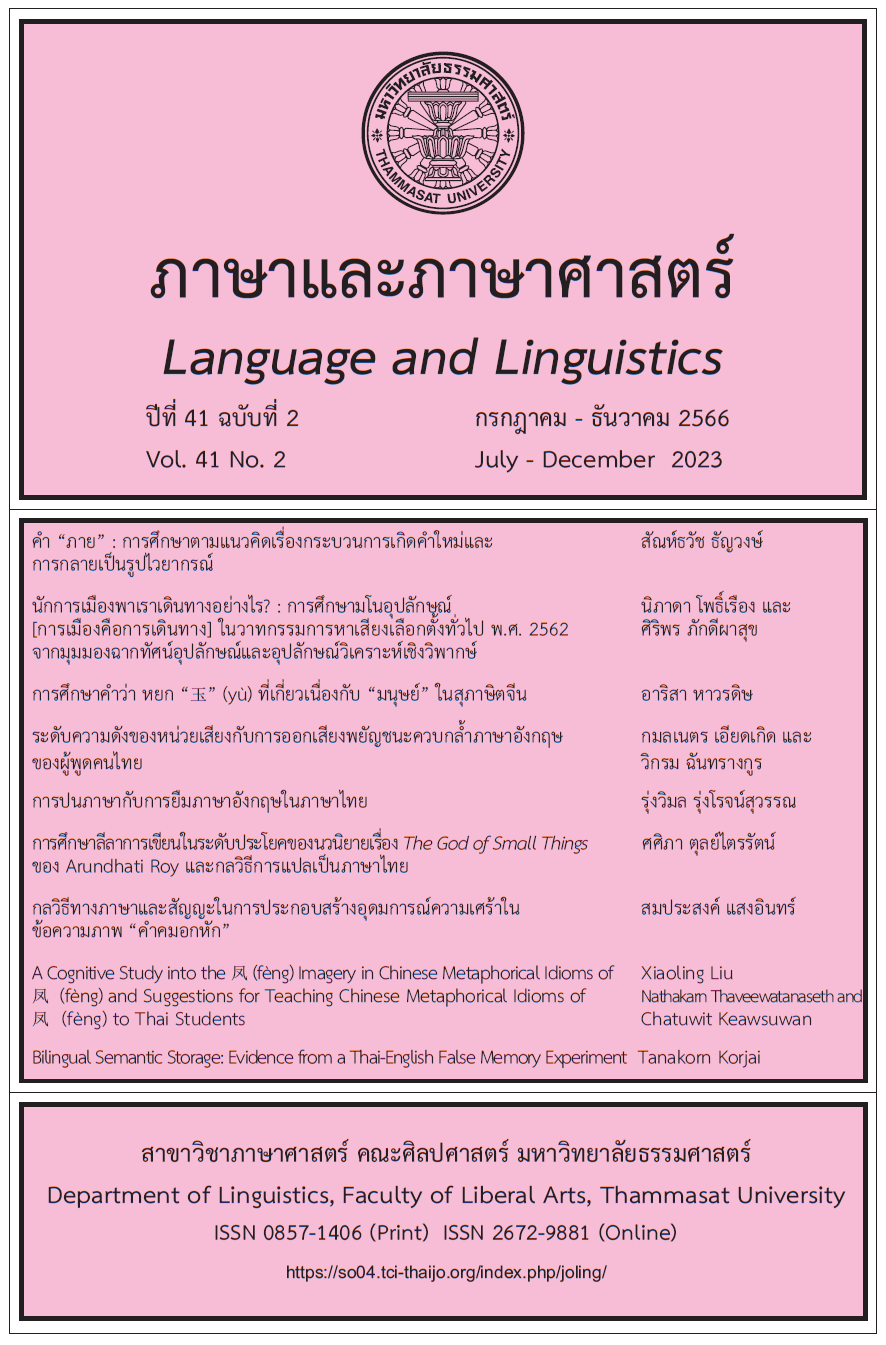How Do Politicians Guide Us in a Journey?: A Study of POLITICS IS A JOURNEY Metaphors in the Campaign for the 2019 Thai General Election from the Approaches of Metaphor Scenario Analysis and Critical Metaphor Analysis
Main Article Content
Abstract
The 2019 general election of members of the house of representatives was an important election in Thailand’s history. The JOURNEY metaphor was one of the devices that politicians used in the election campaign in order to present ideas and political images of themselves and others. This research aims to analyze these POLITICS IS A JOURNEY metaphors adopted in the 2019 election campaign. The research utilized conceptual metaphor theory, the concept of metaphor scenario, and that of critical metaphor analysis as analytical tools. The results of this study revealed that 11 metaphor scenarios were employed which mainly conveyed five ideas about Thai politics; namely, 1) politicians are heroes who lead the way, 2) other politicians are incompetent navigators, and different political ideas are a risky path, 3) the goal of the election is to select a proper path or to remove obstacles from the current path, 4) political success is the ability to overcome obstacles in its path, and 5) Thailand is moving backward and moving forward is at the heart of political progress. It is important to note that no matter how diverse politicians’ ideas are about Thai politics, the main idea underlying them is that politicians are leaders in the journey while people are always followers.
Article Details

This work is licensed under a Creative Commons Attribution-NonCommercial-NoDerivatives 4.0 International License.
บทความทุกบทความเป็นลิขสิทธิ์ของภาษาและภาษาศาสตร์
References
กนกกาญจน์ วรสีหะ. (2555). “การชุมนุมทางการเมืองคือการทำสงคราม” มโนทัศน์ที่สะท้อนจากอุปลักษณ์ข่าวการชุมนุมทางการเมืองจากหนังสือพิมพ์ไทย. วารสารสถาบันวัฒนธรรมและศิลปะ, 13(2), 49-55.
ชัชวดี ศรลัมพ์. (2548). อุปลักษณ์ตามแนวคิดของทฤษฎีภาษาศาสตร์ปริชาน. วารสารศิลปศาสตร์, 5(1), 1-16.
ณัฐพร พานโพธิ์ทอง. (2556). วาทกรรมวิเคราะห์เชิงวิพากษ์ตามแนวภาษาศาสตร์: แนวคิดและการนำมาศึกษาวาทกรรมในภาษาไทย. โครงการเผยแพร่ผลงานวิชาการ คณะอักษรศาสตร์ จุฬาลงกรณ์มหาวิทยาลัย.
ไทยพีบีเอส. (2562). ยอดสมัคร ส.ส.วันแรกพุ่ง 5,831 คน ทุบสถิติปี 2554. https://news.thaipbs.or.th/content/277516
นันทนา วงษ์ไทย. (2552). อุปลักษณ์ประสาทสัมผัสในภาษาไทย: การศึกษาตามแนวภาษาศาสตร์ปริชาน [วิทยานิพนธ์ปริญญาดุษฎีบัณฑิต]. มหาวิทยาลัย ธรรมศาสตร์.
ปิยภรณ์ อบแพทย์. (2552). อุปลักษณ์เกี่ยวกับชีวิตในหนังสือธรรมะ [วิทยานิพนธ์ปริญญามหาบัณฑิต]. จุฬาลงกรณ์มหาวิทยาลัย.
ปิยภรณ์ อบแพทย์. (2563). มโนอุปลักษณ์เพศชาย เพศหญิง และเพศทางเลือกในวาทกรรมสาธารณะ: กรณีศึกษาบทละครโทรทัศน์และเพลงไทยสากล [วิทยานิพนธ์ปริญญาดุษฎีบัณฑิต]. จุฬาลงกรณ์มหาวิทยาลัย.
พิษณุ บางเขียว. (2544). รูปภาษาแสดงอุปลักษณ์ในข่าวการเมือง. ใน อัควิทย์ เรืองรอง (บรรณาธิการ), มนุษยศาสตร์ สังคมศาสตร์: พลังปัญญา: รวมบทความด้านมนุษยศาสตร์และสังคมศาสตร์ (พิมพ์ครั้งที่ 1, น. 81-90). คณะมนุษยศาสตร์และสังคมศาสตร์ สถาบันราชภัฏบ้านสมเด็จเจ้าพระยา.
มิรินด้า บูรรุ่งโรจน์. (2548). อุปลักษณ์เชิงมโนทัศน์เกี่ยวกับผู้หญิงในบทเพลงลูกทุ่งไทย [วิทยานิพนธ์ปริญญามหาบัณฑิต]. มหาวิทยาลัยธรรมศาสตร์.
รัชนีย์ญา กลิ่นน้ำหอม. (2551). อุปลักษณ์ที่นักการเมืองไทยใช้: การศึกษาตามแนวภาษาศาสตร์ปริชานและวัจนปฏิบัติศาสตร์ [วิทยานิพนธ์ปริญญาดุษฎีบัณฑิต].
จุฬาลงกรณ์มหาวิทยาลัย.
ศิริพร ภักดีผาสุข. (2561). ความสัมพันธ์ระหว่างภาษากับอัตลักษณ์และแนวทางการ นำมาศึกษาภาษาไทย. โครงการเผยแพร่ผลงานวิชาการ คณะอักษรศาสตร์ จุฬาลงกรณ์มหาวิทยาลัย.
สุกัญญา รุ่งแจ้ง. (2548). อุปลักษณ์เชิงมโนทัศน์ของการ ใช้คำว่า “ใจ” ในภาษาไทย [วิทยานิพนธ์ปริญญามหาบัณฑิต]. มหาวิทยาลัยธรรมศาสตร์.
อุษา พฤฒิชัยวิบูลย์. (2544). การศึกษาอุปลักษณ์เรื่องการเมืองในภาษาไทยตามแนวอรรถศาสตร์ปริชาน [วิทยานิพนธ์ปริญญามหาบัณฑิต]. มหาวิทยาลัยธรรมศาสตร์.
Bangnokwag, W. (2003). A study of political metaphor on the front page of two Thai English newspapers [Master’s thesis]. Srinakarinwirot University.
Charteris-Black, J. (2004). Corpus approaches to critical metaphor analysis. Palgrave Macmillan.
Charteris-Black, J. (2005). Politicians and rhetoric: the persuasive power of metaphor. Palgrave Macmillan.
Charteris-Black, J. (2011). Politicians and rhetoric: the persuasive power of metaphor (2nd ed.). Palgrave Macmillan.
Charteris-Black, J. (2018). Analysing political speeches: Rhetoric, discourse and metaphor (2nd ed.). Palgrave Macmillan.
Fauconnier, G., & Turner, M. (2002). The way we think: Conceptual blending and the mind’s hidden complexities. Basic Books.
Fauconnier, G., & Turner, M. (2003). Conceptual blending, form and meaning. In P. Fastrez (Ed.), Recherches en communicationSémiotique, 19, 57-86.
Fillmore, C. J. (1975). An alternative to checklist theories of meaning. In C. Cogen (Ed.), Proceedings of The First Annual Meeting of the Berkeley Linguistics Society (pp. 123-131). https://doi.org/10.3765/bls.v1i0.2315
Lakoff, G. (1987). Women, fire, and dangerous things what categories reveal about the mind. University of Chicago Press.
Lakoff, G., & Johnson, M. (1980). Metaphors we live by. University of Chicago Press.
Musolff, A. (2006). Metaphor scenarios in public discourse. Mataphor and Symbol, 21(1), 23-38.
Musolff, A. (2016). Political metaphor analysis: Discourse and scenarios. Bloomsbury.
Turner, M., & Fauconnier, G. (2003). Metaphor, metonymy, and binding. In R. Dirven & R. Pörings (Eds.), Metaphor and metonymy in comparison and contrast (pp. 469-487). De Gruyter.


